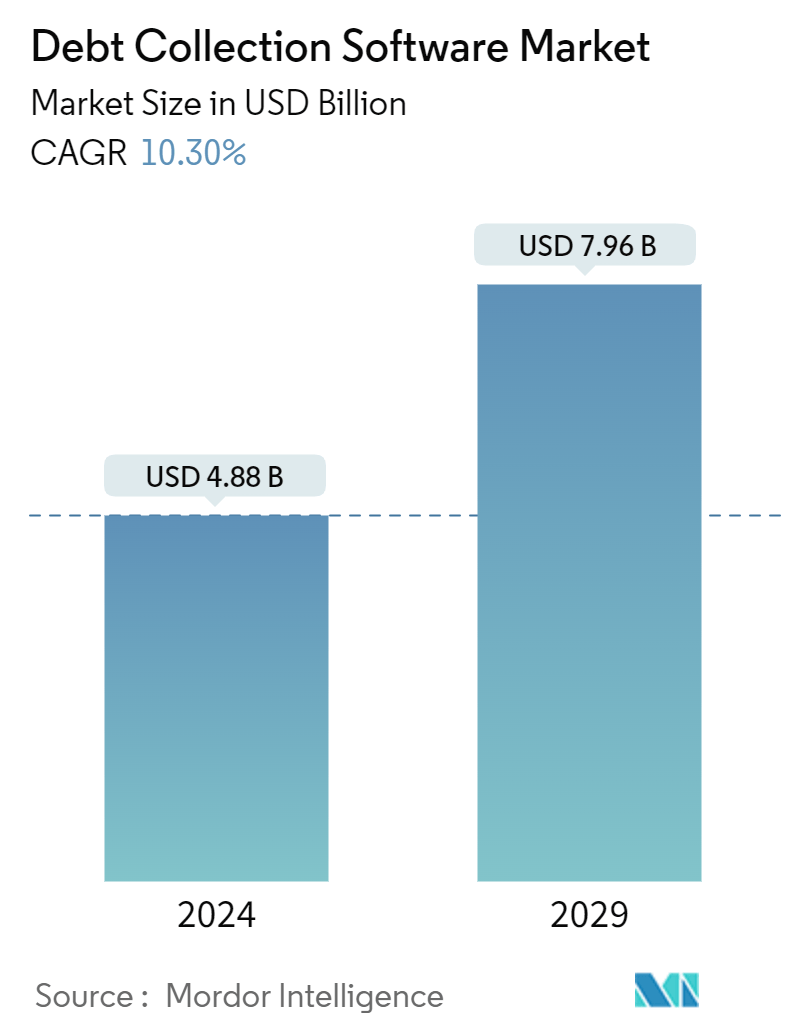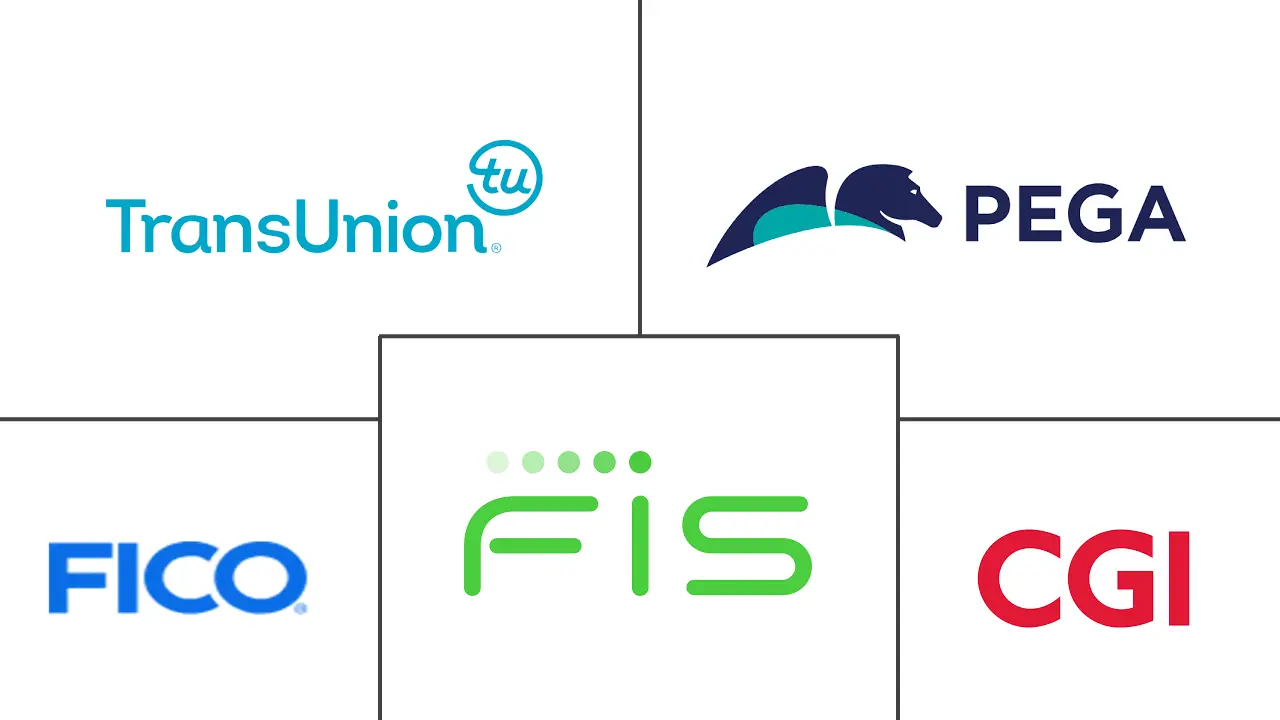Market Size of Debt Collection Software Industry

| Study Period | 2022 - 2029 |
| Market Size (2024) | USD 4.88 Billion |
| Market Size (2029) | USD 7.96 Billion |
| CAGR (2024 - 2029) | 10.30 % |
| Fastest Growing Market | Asia Pacific |
| Largest Market | North America |
Major Players
*Disclaimer: Major Players sorted in no particular order |
Debt Collection Software Market Analysis
The Debt Collection Software Market size is estimated at USD 4.88 billion in 2024, and is expected to reach USD 7.96 billion by 2029, growing at a CAGR of 10.30% during the forecast period (2024-2029).
- The growth of the market is majorly attributed to the increasing automation in the debt collection process, such as personalizing customer experience through the integration of AI and ML, Continuous innovations to meet consumer demand, predicting default probability through automation, and outsourcing debt recovery to specialized debt collection agencies.
- The most significant beneficiary of the technology-based banking method has been the digital lending market. Data-driven technology, machine learning, and other commitments are critical elements in the evolution of digital lending from traditional paperwork and formalities. Models such as P2P lending, SME financing, short-term loans, and credit cards generate a digital loan market.
- Companies can target their loans to customers due to the availability of large amounts of customer data, one of the most significant growth drivers in the digital lending sector. Further, compared to other business models in the field of fintechs, such as payments and finance services, digital lending offers greater margins.
- Digitization has become a necessity for banks in view of the growing demand for credit, increased awareness of financial matters, and an expectation that the process will go smoothly. The growth of digital lending is analyzed to create significant borrower data and other data that could be used efficiently in the debt collection software. A practical solution to automating the collection process is using debt collection software or collections CRM that allows lenders to track and follow up with debtors efficiently, predict and prioritize debt recovery, and enable faster collections. This is analyzed to boost the market’s growth rate during the forecast period.
- The management of debt collection activities has been significantly hindered by legacy systems, which can be described by out-of-date technology, restricted functionality, and inflexible architecture. These limitations have driven the debt collection software market to witness a surge in demand for modern, agile, and adaptable solutions capable of addressing the evolving complexities of debt management.
- Debt collection software has transformed due to the COVID-19 pandemic because lenders must adapt to the latest risk procedures, including new risk technology and risk-evaluation indicators. The need to unify various risk solutions by using AI technologies and enhance overall implementation processes has enhanced market growth post-pandemic.
Debt Collection Software Industry Segmentation
Debt collection software, also called accounts receivable management (ARM) software, supports the needs of agencies and lenders by providing business process automation, compliance assurance, and other features essential to orderly and effective collections efforts. B2B collectors generally use debt collection software to collect commercial debts accumulated through service transactions.
The debt collection software market is segmented into deployment type, organization size, end user, and geography. By deployment type, the market is segmented into cloud-based and on-premise. By organization size, the market is segmented into large enterprises and small and medium-sized enterprises. By end user, the market is segmented into financial institutions (banks and NBFC), collection agencies, healthcare, government, telecom and utilities, and other end users. By geography, the market is segmented into North America, Europe, Asia-Pacific, Latin America, and Middle East and Africa. The report also offers market size and forecasts for the debt collection software market in 10 countries across the major regions.
The report offers market forecasts and size in value (USD) for all the above segments.
| By Deployment | |
| Cloud-based | |
| On-premise |
| By Organization Size | |
| Large Enterprises | |
| Small and Medium-sized Enterprises |
| By End User | |
| Financial Institutions (Banks and NBFC) | |
| Collection Agencies | |
| Healthcare | |
| Government | |
| Telecom and Utilities | |
| Other End Users (Real Estate and Retail) |
| By Geography | ||||||
| ||||||
| ||||||
| ||||||
| ||||||
| Middle East and Africa |
Debt Collection Software Market Size Summary
The debt collection software market is poised for significant growth, driven by the increasing automation of debt collection processes and the integration of advanced technologies such as artificial intelligence and machine learning. This transformation is largely fueled by the need for personalized customer experiences and the ability to predict default probabilities through automation. The digital lending sector, benefiting from data-driven technologies, plays a crucial role in this expansion, offering greater margins compared to other fintech business models. The shift towards digitization in the banking sector, prompted by rising credit demand and the necessity for seamless processes, further propels the market. Modern debt collection software solutions are essential for overcoming the limitations of legacy systems, which hinder efficient debt management. The COVID-19 pandemic has accelerated the adoption of these technologies, as lenders adapt to new risk procedures and seek to unify various risk solutions using AI.
In regions like China and India, the debt collection software market is experiencing substantial growth due to the increasing demand for automated solutions to minimize bad debt. The presence of global market vendors and technological advancements in debt collection practices are key factors driving this growth. The Asia-Pacific region, including countries such as Australia, Japan, and South Korea, is also witnessing significant market expansion, fueled by the need for automated debt collection in various industries. The market landscape is semi-consolidated, with major players like Fidelity National Information Services, CGI Inc., and Pegasystems Inc. actively engaging with digital technology startups to introduce advanced solutions. Strategic partnerships and technological integrations among key industry players are enhancing the capabilities of debt collection software, further supporting market growth.
Debt Collection Software Market Size - Table of Contents
-
1. MARKET INSIGHTS
-
1.1 Market Overview
-
1.2 Industry Attractiveness - Porter's Five Forces Analysis
-
1.2.1 Bargaining Power of Suppliers
-
1.2.2 Bargaining Power of Buyers
-
1.2.3 Threat of New Entrants
-
1.2.4 Threat of Substitutes
-
1.2.5 Intensity of Competitive Rivalry
-
-
1.3 Assessment of Impact of COVID-19 on the Debt Collection Software Market
-
-
2. MARKET SEGMENTATION
-
2.1 By Deployment
-
2.1.1 Cloud-based
-
2.1.2 On-premise
-
-
2.2 By Organization Size
-
2.2.1 Large Enterprises
-
2.2.2 Small and Medium-sized Enterprises
-
-
2.3 By End User
-
2.3.1 Financial Institutions (Banks and NBFC)
-
2.3.2 Collection Agencies
-
2.3.3 Healthcare
-
2.3.4 Government
-
2.3.5 Telecom and Utilities
-
2.3.6 Other End Users (Real Estate and Retail)
-
-
2.4 By Geography
-
2.4.1 North America
-
2.4.1.1 United States
-
2.4.1.2 Canada
-
-
2.4.2 Europe
-
2.4.2.1 United Kingdom
-
2.4.2.2 Germany
-
2.4.2.3 Spain
-
2.4.2.4 Rest of Europe
-
-
2.4.3 Asia-Pacific
-
2.4.3.1 China
-
2.4.3.2 India
-
2.4.3.3 Rest of Asia-Pacific
-
-
2.4.4 Latin America
-
2.4.4.1 Brazil
-
2.4.4.2 Mexico
-
2.4.4.3 Colombia
-
2.4.4.4 Rest of Latin America
-
-
2.4.5 Middle East and Africa
-
-
Debt Collection Software Market Size FAQs
How big is the Debt Collection Software Market?
The Debt Collection Software Market size is expected to reach USD 4.88 billion in 2024 and grow at a CAGR of 10.30% to reach USD 7.96 billion by 2029.
What is the current Debt Collection Software Market size?
In 2024, the Debt Collection Software Market size is expected to reach USD 4.88 billion.

